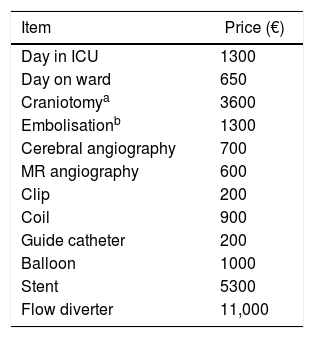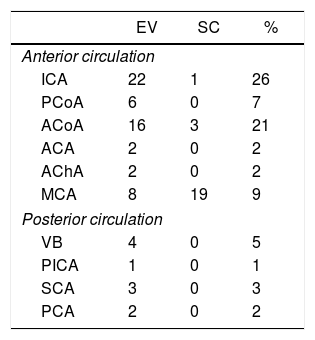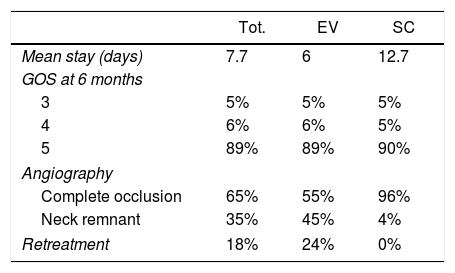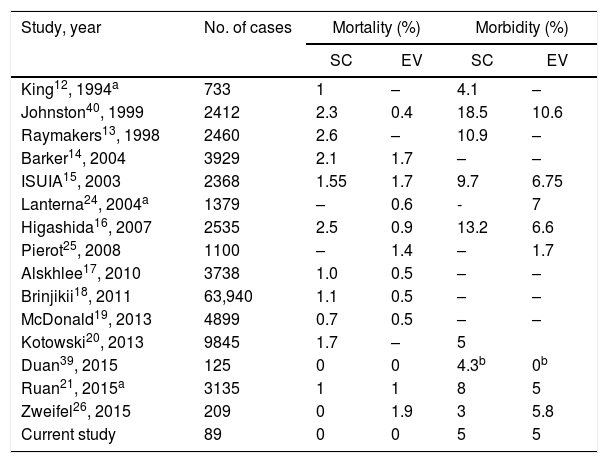To evaluate the results and costs of surgical treatment against endovascular in non-ruptured aneurysms.
Material and methodsRetrospective study of consecutive series non-ruptured aneurysms from a single-centre treated endovascularly (EV) and surgically (SC). A descriptive study of demographic (age, sex), characteristics of the patients and the radiological aspects of the aneurysms have been carried out. Clinical results (GOS at 6 months), angiographic data (occlusion classification) and economic costs have been evaluated in both globally, and in each of the groups.
Results89 patients treated between 2010 and 2015 were reviewed. Most of them were treated endovascularly (74%). There were no statistically significant differences between EV and SC groups. 89% of the patients presented favourable GOS (4–5) at six months, being this percentage similar in both groups. Complete occlusion was much higher in SC group (96%) than in EV (55%). Retreatment rate was 24% in EV group and 0% in SC group. The retreatments were more frequent in anterior circulation aneurysms and bigger aneurysms (>10mm). The expenses in the SC group come mainly from hospital stay, meanwhile in the EV group is due to embolisation materials. The average length of stay (ALOS) is higher in SC group but costs of first admission are higher in EV group (14% more). When the costs of retreatments and follow up are included the costs of endovascular treatment is much higher than the surgical (61% more expensive).
Conclusionsresults of both types of treatment are comparable. The grade of aneurysmal occlusion of the SC group was higher than the EV, as well as the stability of the treatment, requiring fewer retreatments. Although the ALOS in SC group were longer, the costs of the EV group were significantly higher than the SC group due to the costs of embolisation materials, follow up that they need and the rate of retreatment. Adequate selection of candidates for endovascular coiling could improve angiographic outcomes, reduce retraction rates, and save costs.
Evaluar los resultados clínicos y angiográficos, así como los costes del tratamiento quirúrgico frente al endovascular, en el tratamiento de los aneurismas incidentales.
Material y métodosEstudio retrospectivo de una serie consecutiva de 89 pacientes de un solo centro tratados endovascularmente (EV) y quirúrgicamente (SC). Se realiza estudio descriptivo de aspectos demográficos (edad, sexo) y de las características de los aneurismas así como se evalúan resultados clínicos (GOS a 6 meses), angiográficos (grado de oclusión) y de costes económicos tanto globalmente como de cada uno de los grupos.
ResultadosOchenta y nueve pacientes tratados entre 2010 y 2015. Un 74% de los pacientes recibieron tratamiento endovascular y un 26% quirúrgico. No hubo diferencias significativas en cuanto a edad o sexo entre los grupos EV y SC. Un 89% de los pacientes presentaron GOS a los 6 meses favorable (4-5), sin diferencias entre ambos grupos. La oclusión completa del aneurisma fue mayor en el grupo SC (96% versus 55%), así como la estabilidad del tratamiento (24% de retratamientos en el grupo EV versus 0% en el grupo SC). Los retratamientos son más frecuentes en aneurismas de circulación anterior (27%) y de mayor tamaño (un 38,5% de los mayores de 10 mm). El gasto en el grupo SC viene derivado fundamentalmente de la estancia hospitalaria en tanto que en grupo EV tiene más importancia el coste de los materiales de embolización. Las estancias medias son notablemente superiores en el grupo SC pero el coste medio del primer ingreso es un 14% superior en el grupo EV debido al precio de los materiales de embolización. El gasto total es notablemente superior en el grupo EV (un 61%) debido a los gastos derivados del seguimiento y de los retratamientos.
ConclusionesLos resultados clínicos de ambos tipo de tratamiento son comparables. El grado de oclusión aneurismática del grupo SC es superior al del EV, así como la estabilidad del tratamiento, precisando menos retratamientos. A pesar de que el tratamiento quirúrgico genera estancias más largas, los costes del grupo EV son notablemente superiores a los del grupo SC debido al precio de los materiales de embolización, el seguimiento que precisan y la tasa de retratamientos. Una adecuada selección de los casos candidatos a coiling o pinzamiento podría mejorar los resultados angiográficos, reducir la tasa de retratamientos y ahorrar costes.
Article

If it is the first time you have accessed you can obtain your credentials by contacting Elsevier Spain in suscripciones@elsevier.com or by calling our Customer Service at902 88 87 40 if you are calling from Spain or at +34 932 418 800 (from 9 to 18h., GMT + 1) if you are calling outside of Spain.
If you already have your login data, please click here .
If you have forgotten your password you can you can recover it by clicking here and selecting the option ¿I have forgotten my password¿.














